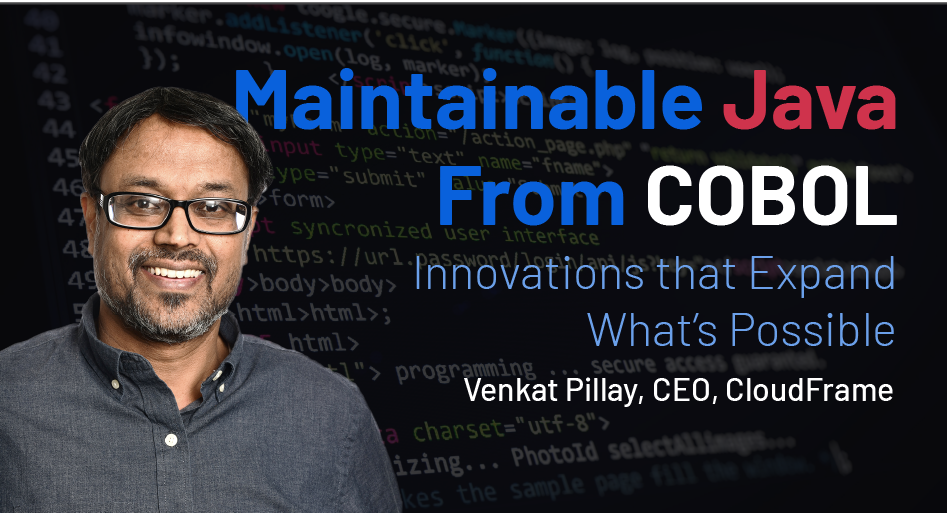Moving from Greenfield Application Modernization to Bluefield with CloudFrame Renovate

In the first three posts in this series, we looked at the commonly-made case for “greenfield” COBOL-to-Java application modernization efforts, the most frequent ways such initiatives go wrong, and how tool-assisted transformation offers a better way to achieving most of the strategic goals companies are hoping for from modernization, at much-reduced levels of risk and opportunity cost. In this final post, we’ll examine how CloudFrame Renovate—the “tool” in “tool-assisted transformation”—delivers on the promise of application modernization with innovative capabilities that mitigate the challenges of modernizing COBOL.
At the highest level, Renovate breaks up sometimes multi-hundred-thousand-line monolithic COBOL programs into reusable and modifiable microservice structures. Its transformation power lies in the product’s ability to transform coding structures and concepts native to COBOL into systems expressed in well-annotated Java, easily understandable by Java programmers. For example, COBOL’s complicated (and numerous) data types are converted by Renovate into Java’s more straightforward range of data types without loss of functionality. Similarly, COBOL’s tendency to use predominantly global variables is transformed into Java-friendly collections of well-defined inputs and outputs for methods. At the same time, COBOL status codes are reconfigured into proper Java exception-handling routines.
At Scale
The core value of Renovate isn’t in producing pristine, “production ready” Java from a COBOL source system. Instead, it creates developer-ready Java that is interpretable, improvable, and maintainable by Java coders who don’t know COBOL. When organizations modernize with Renovate, they determine their position on the range of Greenfield (application code free of any legacy influence) and Brownfield (application code functionally equivalent to the legacy system), arriving at the Bluefield spot on the range. Renovates’ Bluefield transformation capability can be tuned to an organization’s unique requirements and can even vary from one application to the next. This provides both repeatable and consistent outcomes and needed flexibility.
Functional equivalence can be a critical requirement for getting a business to certify and accept the new system; if calculation results in the Java application code do not perfectly match calculation results in the original COBOL, parallel production runs are often demanded to cycle both systems through seasons and scenarios, validating the new against the old as they run. This can take years, massively extending the time needed to capture the anticipated business value from modernization and creating tremendous risk and costs.
Looking to the Future
CloudFrame continues to enhance the software’s capabilities as both a tool and as a broader offering, with large language model (LLM) AI(s) significantly influencing the evolution of Renovate. To date, the tool has been a highly effective example of a “deterministic” transformer—that is, one based on explicit rules that produce fully traceable and entirely predictable output. By comparison, the transformer model of LLMs is a “probabilistic” one based on the statistical prediction of outputs. Therefore, its product is much less predictable and usually untraceable, requiring significant human intervention to validate. As discussed above, a COBOL-to-Java conversion process based solely on this approach would create less trust in results, and for organizations seeking functional equivalence, achieving it would become a guessing game.
Yet the potential of probabilistic transformation can be harnessed if done intelligently. CloudFrame’s approach is to combine the “pre-training” of a transformer (that’s the “PT” in “GPT”) with expert-led “post-training” that will narrow and reconfigure a transformer model’s zone of attention from “all language everywhere” to the specific COBOL-Java domain and its many unique attributes and structures. This approach relieves the tremendous risk of application replacement and business disruption for organizations that rely on mission-critical COBOL applications but want to break away from the mainframe.
From Greenfield to Bluefield
While the allure of greenfield modernization remains enticing when viewed from a distance, up close (and with the benefit of experience), its many risks become apparent. And given the availability of practical transformation tools like Renovate, which can massively reduce the amount of expensive human effort, shorten the time to value (while lowering the opportunity costs from tied up resources), and improve code consistency and traceability—the case for starting from scratch is weaker than ever. Not only is there a better way, but it’s also getting better with innovation to CloudFrame technology and a Bluefield application modernization approach.
To explore deeper into Renovate’s current capabilities and future enhancements, watch this webinar, featuring CloudFrame CEO Venkat Pillay.
Releted Tags
Related Post

Simplest Way to Move a Mainframe Application to the Cloud
The never-ending and often contentious debate about the mainframe remains quite vocal…
MicroFocus® Modernization
"How did I end up with a Legacy COBOL application on a modern…

Why you need to know the difference between a TCB…
Units of work that run on the mainframe, at least those running…


Recent Comments